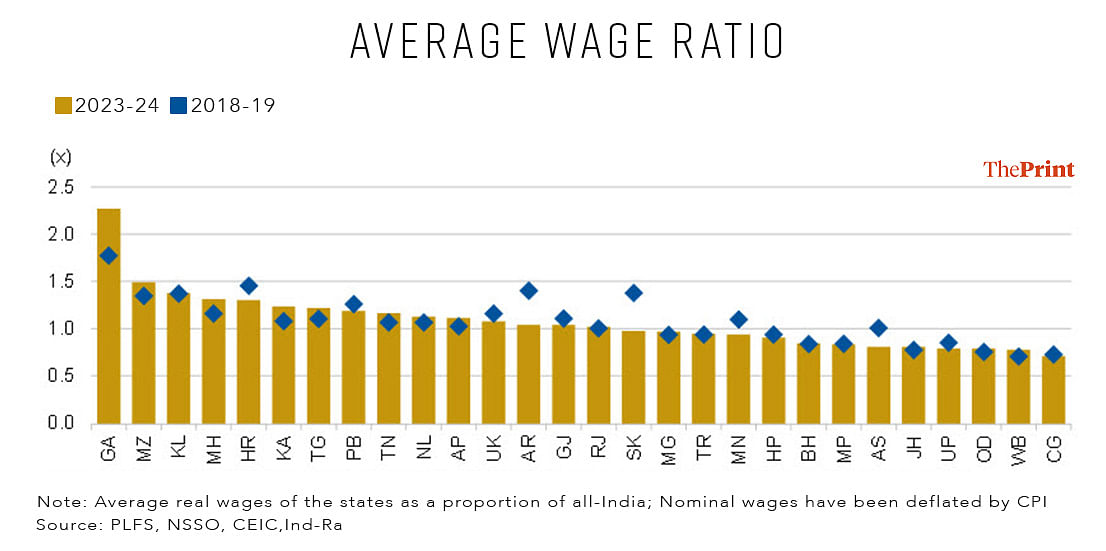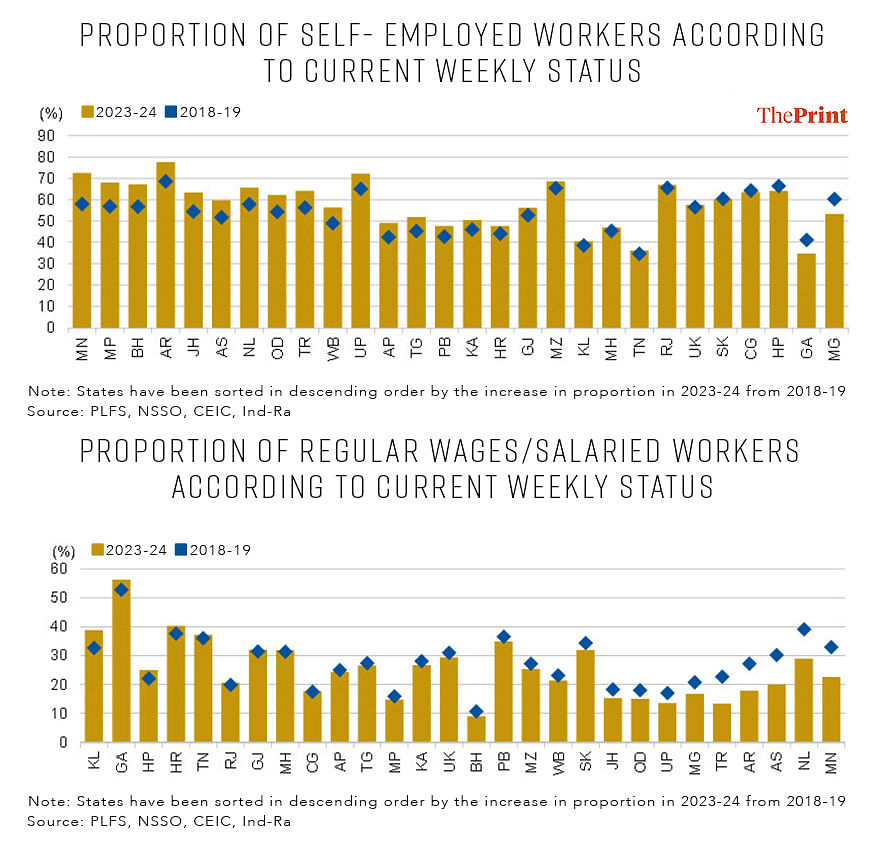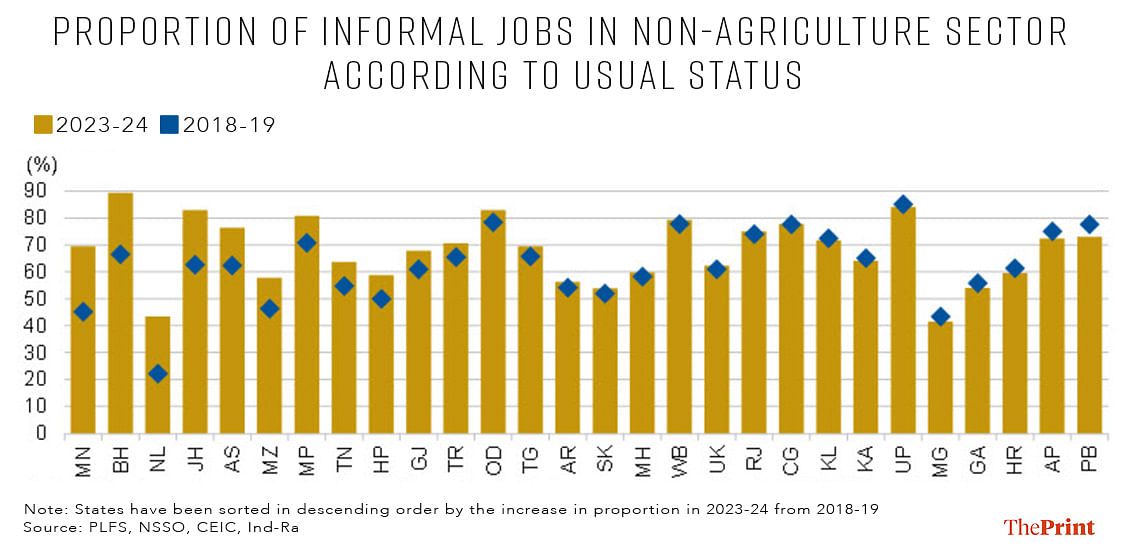New Delhi: Real wages, which incorporate for the impact of inflation, have remained nearly unchanged over the last five years for India as a whole, while they have contracted in some states, such as Haryana and Uttar Pradesh, a new analysis has revealed.
In a report titled ‘State Labour Force Digest — Profiling Labour Dynamics of Indian States’, ratings agency India Ratings and Research (Ind-Ra) arrives at these conclusions, using government data from the various periodic labour force surveys. Its analysis covers the period between Q2 of FY20 and Q1 of the current financial year 2024-25.
“The Periodic Labour Force Survey (PLFS) report provides wages/earnings data based on different employment status for India and various sub-national economies,” the report said. “The overall real wage (nominal wages deflated by state-specific Consumer Price Index) growth at the national level has been flat at 0.01 percent over 2QFY20-1QFY25.”
However, it did point out that 17 of the 28 states in its analysis saw a higher real wage growth than the national average. For instance, it said, during the last five years or so, the real wage growth was above two percent year-on-year for Karnataka, Maharashtra and Telangana, between one percent and two percent every year for Andhra Pradesh, Tamil Nadu, West Bengal and Jharkhand, and a robust 6.8 percent year-on-year for Goa, among the small states.
“On the other hand, Haryana and Uttar Pradesh witnessed a contraction of (an average of) 1.7 percent year-on-year and 1.2 percent year-on-year, respectively, in the real wages during 2QFY20-1QFY25,” the report said. “Among the small states, Arunachal Pradesh, Manipur and Assam were the ones to have recorded a severe contraction (more than three percent year-on-year) in real wages in the same period.”
Haryana—falling down the ranks

The report also arrived at a metric called the average wage ratio, which measures the average real wages of a state relative to the national level. The data shows that 15 of 28 states had average wages higher than the national average in 2023-24, down from 18 states in 2018-19.
According to the report, Goa ranked the highest in the average wage ratio with its average wages 2.27 times the national level in 2023-24, followed by Mizoram, which, in 2023-24, jumped four spots up from 2018-19.
Apart from these two, Kerala, Maharashtra and Haryana were among the five states with the highest average wage ratios.
However, while Haryana’s average wages were still 1.2-1.3 times the national average, the contraction in its real wages has affected its relative position in the country.
“Although Haryana remained in the top five in 2023-24, its position slipped from second in 2018-19,” the report noted. “Jharkhand, Uttar Pradesh, Odisha, West Bengal and Chhattisgarh were the bottom five states during 2023-24.”
ThePrint previously reported on the high rate of reverse migration in Haryana, with its workers transitioning back to agriculture at a far higher rate than in other states that remain mainly agrarian. Experts then said the phenomenon was due to Haryana’s inability to create high-quality non-agricultural jobs.
Also Read: India slams the brakes on surge in Chinese solar imports, but domestic industry still needs them
Deteriorating quality of jobs

The deteriorating quality of jobs is also evident at the all-India level, according to the data. The proportion of self-employed workers in India’s workforce rose to 57.7 percent in 2023-24 from 51.6 percent in 2018-19.
The increase in the share of self-employed workers was the highest in Manipur, Madhya Pradesh and Bihar. Manipur saw its share of self-employed workers rise by 14.5 percentage points, MP by 11.1 and Bihar by 10.4.
Only four states—Meghalaya, Goa, Himachal Pradesh and Chhattisgarh—saw a decline in the share of self-employed workers.
“The high quantum of increase in self-employed workers suggests that it has come at the expense of regular wages/salaried workers,” the report noted.
The data showed that India’s share of regular wage or salaried workers fell to 23.2 percent in 2023-24 from 25.2 percent in 2018-19. The report said that that was the trend in 19 of 28 states.
Uttar Pradesh recorded the steepest fall in the share of salaried workers by 3.6 percentage points. Among bigger states, Odisha and Jharkhand followed UP, registering a three-percentage-point fall each. Among smaller states, Manipur’s share of salaried workers fell by 10.4 percentage points, and Nagaland’s and Assam’s by 10.2 percentage points each.
On the other hand, Kerala and Goa saw their shares of salaried workers rise by 6.2 and 3.4 percentage points, respectively, between 2018-19 and 2023-24.
Moving towards more informal jobs

The other metric that points to the deteriorating quality of jobs in India is the trend of an increasing number of informal sector workers.
“At the national level, 73.2 percent of workers were engaged in informal jobs in the non-agriculture sector in 2023-24—increasing by 4.8 percentage points from 2018-19,” the report said. “The increase in share of informal jobs within the non-agriculture sector was prevalent in 20 states.”
Of these 20 states, 11 saw a higher increase in their shares of non-agricultural informal jobs than the national-level figure.
“This was led by Bihar and Jharkhand where the share of informal jobs within the non-agriculture sector increased by 22.9 percentage points and 20.3 percentage points, respectively, to be above 80 percent in 2023-24,” the report said. “In fact, Bihar now has the highest share of informal jobs within the non-agriculture sector in the country.”
Among the smaller states, Manipur and Nagaland recorded the biggest jump in their shares of informal jobs within the non-agriculture sector by 24.3 and 21.1 percentage points, respectively, compared to 2018-19.
(Edited by Madhurita Goswami)
Also Read: SECI says power producers like Adani & Azure have option to cut tariffs if nobody’s buying






